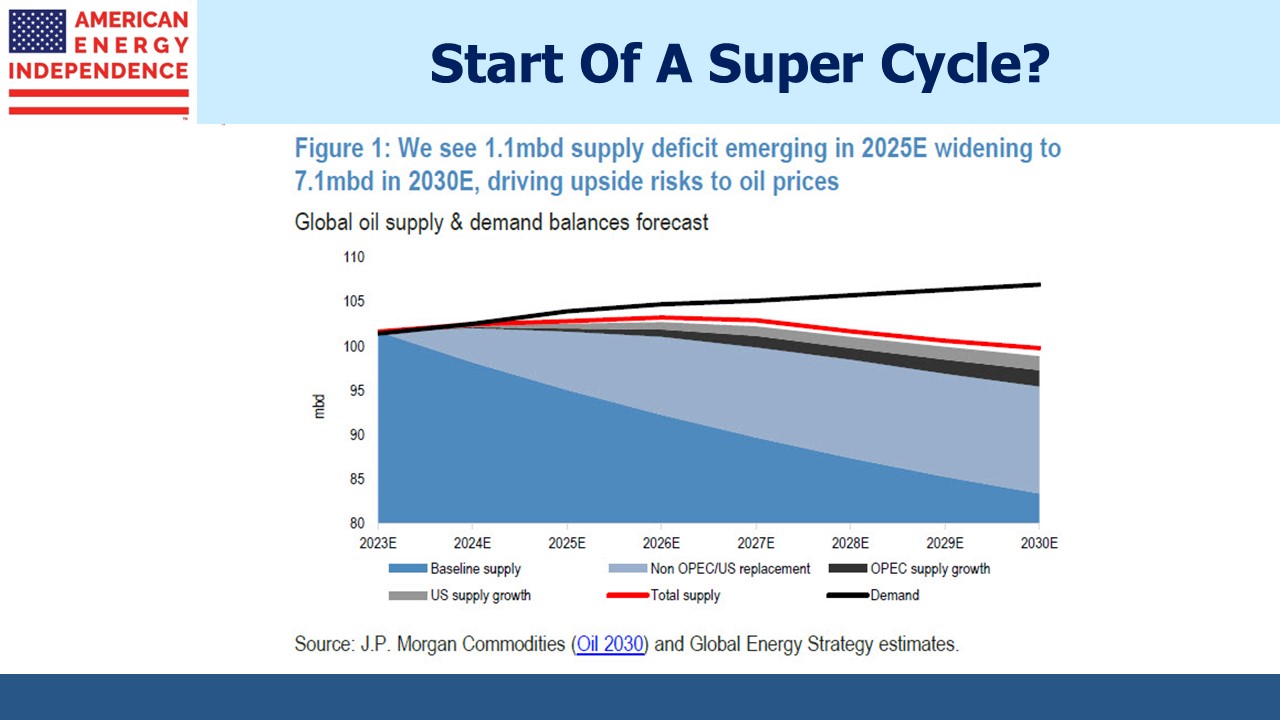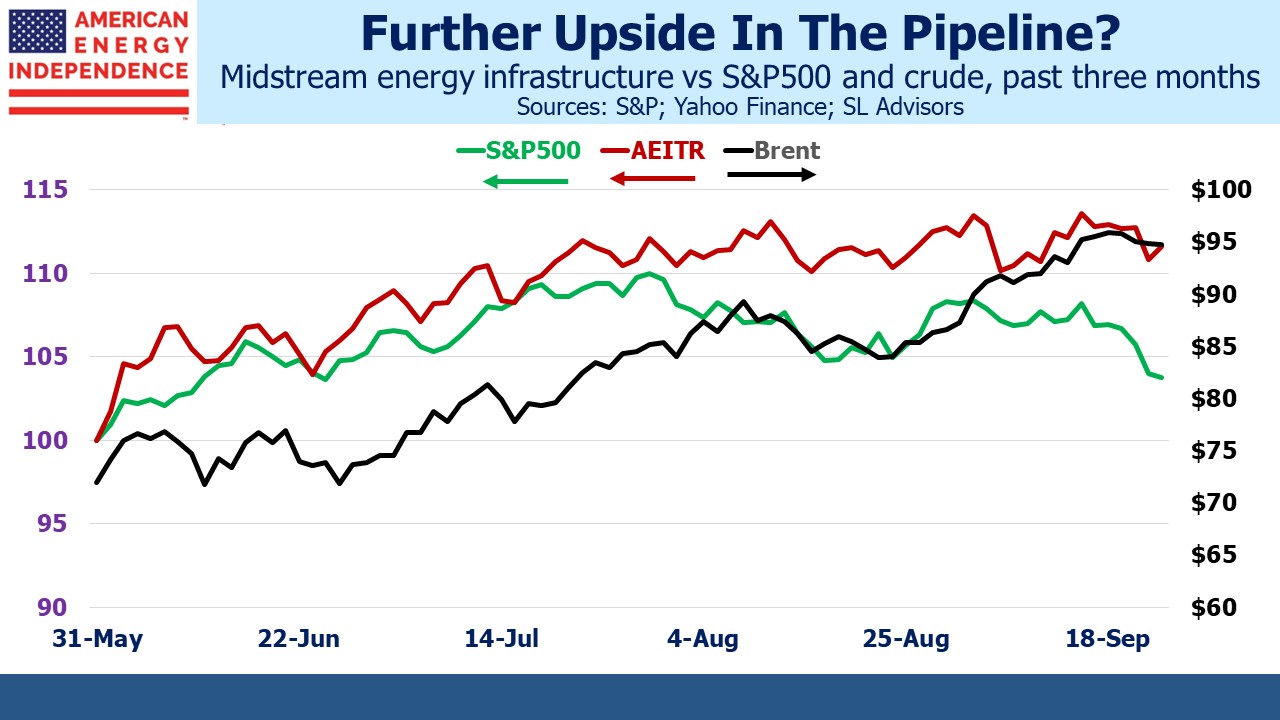In March of 2020 when crude oil was collapsing dragging energy stocks, including pipelines, along, I tried to focus on the positive, which was that it had become cheaper to drive places. Except there was nowhere to go because of the lockdown. And even if there had been, I would have had to make roughly three round trips to the moon and back to generate enough savings on gasoline to compensate for my losses on infrastructure.
What some might deem an imprudently high allocation to the sector was paired with a timid appetite for leverage (ie there was none). With no need to sell I was miserable only until prices started recovering. Having endured low oil prices, I find high prices wholly more agreeable.
(Click on image to enlarge)

Therefore, JPMorgan’s chart depicting a widening supply deficit over the next several years causes me little angst. Those around me might even enjoy my pleasant demeanor if the forecast is true.
Interestingly, JPMorgan’s 2028 forecast of global demand matches the International Energy Agency (IEA) in their Oil 2023 publication at 105.7 Million Barrels per Day (MMB/D), an annual growth rate of just under 1%. Both agree that gasoline demand will soften while other oil products such as jetfuel, LPG and heating oil will continue to rise.
However, they reach very different conclusions on supply. The IEA is more bullish on US output, and therefore doesn’t foresee a supply/demand imbalance. By contrast, JPMorgan expects only 1% annual US production growth. They attribute this to (1) declining productivity, (2) continued focus on accretive projects to drive shareholder returns, and (3) higher interest rates. They see US upstream capex declining 7% annually through 2030.
The result is that JPMorgan is overweight global energy, proclaiming the “Supercycle returns.” They believe, “the upside risk to oil is $150 per barrel over the near to medium term.” They see a “higher for longer” outlook as financial discipline and increased cost of capital combine with “institutional and policy led pressures driving an accelerated transition away from hydrocarbons and peak demand fears.”
The IEA report strikes a more politically correct tone, asserting that increased investment in renewables is bringing “peak oil demand into view.” Reading it is supposed to leave investors in traditional energy despondent. JPMorgan disagrees: “We don’t see peak oil demand on our investment horizon (2030)”. They have a multi-year bullish outlook.
The IEA has a more optimistic supply view combined with a more pessimistic demand outlook. Energy producers embracing both would be disinclined to invest in the very supply growth the IEA expects. They’re forecasting peak oil within a decade or so to stimulate increased capex in oil projects that typically require well over a decade to generate an acceptable return. Only one part of that scenario can plausibly occur.
Analysts at Citi and Bank of America are similarly bullish, which contrarians will view as evidence of an already crowded trade.
(Click on image to enlarge)

If crude oil was falling, we’d note the unimportance of commodity prices to the pipeline sector. Rising prices reflect improving sentiment towards the energy complex and perhaps a modest EBITDA uplift for midstream infrastructure. But given attractive valuations, as generalist investors have begun to revisit their exposure to energy it doesn’t take much to push the sector higher. Market outperformance of the American Energy Independence Index has coincided with the rally in crude oil. They’re likely to continue moving up together.
Oneok’s (OKE) acquisition of Magellan Midstream (MMP) was approved by owners of both companies last week. Now comes the big rebalancing. MMP unitholders will receive $25 per unit, which means about $5BN in cash will be available for reinvestment early this week. Some will be set aside for taxes, but much of what’s left will go back into midstream c-corps, which should give the sector a bid.
$5.6BN is the amount of MLPs the Alerian MLP ETF (AMLP) would have to sell if they decide to rebalance away from the declining MLP sector towards c-corps. Wells Fargo reviewed the challenges this is creating for MLP-dedicated funds that follow Alerian indices. It’s an issue we have noted in the past.
The family of Invesco Steelpath funds would have to sell around $4.5BN in MLPs if they similarly rebalanced. Neither will want to make such a choice after the other. And if Alerian changes their index construction it might force the issue.
As much as $10BN of MLP positions might be swapped into c-corps if such a rebalancing goes ahead. Wells Fargo reviewed the available options but stopped short of predicting what will happen. The issue won’t go away. Fund flows ought to favor c-corps over MLPs.
More By This Author:
Crude Climbs The Wall Of Supply Worries
The Growing LNG Trade
The Sunshine State Runs On Natural Gas
Disclaimer:
The information provided is for informational purposes only and investors should determine for themselves whether a particular service, security or product is suitable for ...
more
Disclaimer:
The information provided is for informational purposes only and investors should determine for themselves whether a particular service, security or product is suitable for their investment needs. The information contained herein is not complete, may not be current, is subject to change, and is subject to, and qualified in its entirety by, the more complete disclosures, risk factors and other terms that are contained in the disclosure, prospectus, and offering. Certain information herein has been obtained from third party sources and, although believed to be reliable, has not been independently verified and its accuracy or completeness cannot be guaranteed. No representation is made with respect to the accuracy, completeness or timeliness of this information. Nothing provided on this site constitutes tax advice. Individuals should seek the advice of their own tax advisor for specific information regarding tax consequences of investments. Investments in securities entail risk and are not suitable for all investors. This site is not a recommendation nor an offer to sell (or solicitation of an offer to buy) securities in the United States or in any other jurisdiction.
References to indexes and benchmarks are hypothetical illustrations of aggregate returns and do not reflect the performance of any actual investment. Investors cannot invest in an index and do not reflect the deduction of the advisor’s fees or other trading expenses. There can be no assurance that current investments will be profitable. Actual realized returns will depend on, among other factors, the value of assets and market conditions at the time of disposition, any related transaction costs, and the timing of the purchase. Indexes and benchmarks may not directly correlate or only partially relate to portfolios managed by SL Advisors as they have different underlying investments and may use different strategies or have different objectives than portfolios managed by SL Advisors (e.g. The Alerian index is a group MLP securities in the oil and gas industries. Portfolios may not include the same investments that are included in the Alerian Index. The S & P Index does not directly relate to investment strategies managed by SL Advisers.)
This site may contain forward-looking statements relating to the objectives, opportunities, and the future performance of the U.S. market generally. Forward-looking statements may be identified by the use of such words as; “believe,” “expect,” “anticipate,” “should,” “planned,” “estimated,” “potential” and other similar terms. Examples of forward-looking statements include, but are not limited to, estimates with respect to financial condition, results of operations, and success or lack of success of any particular investment strategy. All are subject to various factors, including, but not limited to general and local economic conditions, changing levels of competition within certain industries and markets, changes in interest rates, changes in legislation or regulation, and other economic, competitive, governmental, regulatory and technological factors affecting a portfolio’s operations that could cause actual results to differ materially from projected results. Such statements are forward-looking in nature and involves a number of known and unknown risks, uncertainties and other factors, and accordingly, actual results may differ materially from those reflected or contemplated in such forward-looking statements. Prospective investors are cautioned not to place undue reliance on any forward-looking statements or examples. None of SL Advisors LLC or any of its affiliates or principals nor any other individual or entity assumes any obligation to update any forward-looking statements as a result of new information, subsequent events or any other circumstances. All statements made herein speak only as of the date that they were made. r
Certain hyperlinks or referenced websites on the Site, if any, are for your convenience and forward you to third parties’ websites, which generally are recognized by their top level domain name. Any descriptions of, references to, or links to other products, publications or services does not constitute an endorsement, authorization, sponsorship by or affiliation with SL Advisors LLC with respect to any linked site or its sponsor, unless expressly stated by SL Advisors LLC. Any such information, products or sites have not necessarily been reviewed by SL Advisors LLC and are provided or maintained by third parties over whom SL Advisors LLC exercise no control. SL Advisors LLC expressly disclaim any responsibility for the content, the accuracy of the information, and/or quality of products or services provided by or advertised on these third-party sites.
All investment strategies have the potential for profit or loss. Different types of investments involve varying degrees of risk, and there can be no assurance that any specific investment will be suitable or profitable for a client’s investment portfolio.
Past performance of the American Energy Independence Index is not indicative of future returns.
less
How did you like this article? Let us know so we can better customize your reading experience.





